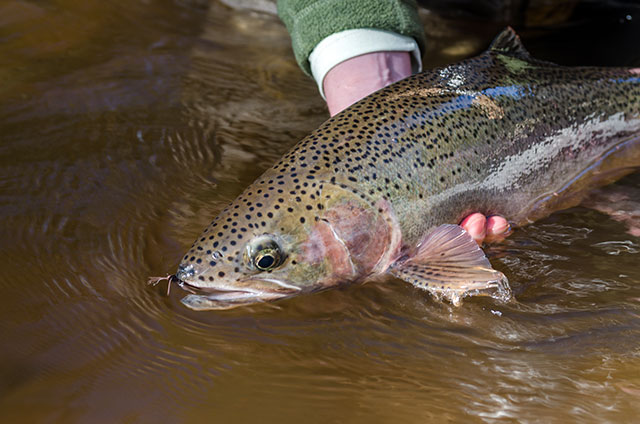“A Superior Fish”

Amy Hazelton photo
They are lake-run rainbow trout, yes. We still call them steelhead, much to the angst of some salty anglers in the Pacific Northwest. But our grandfathers called them steelhead and so we do too, concerned less with water salinity than with the incredible journey they all make to their natal (if not native) headwaters every year.
Of all the Great Lakes steelhead, the Lake Superior steelhead stands apart. It is a wild fish that comes of age in the deep blue of the greatest lake, clear and clean and cold, growing slowly and never reaching the gluttonous size of the Michigan-Huron-Erie-Ontario steelhead. The Superior steelhead makes an unlikely living in the vast lake by eating invertebrates and ciscoes, and occasionally gives the lake trout angler a chrome aerial surprise as it throws his trolled spoon.
The particular Lake Superior steelhead in this story is a South Shore fish that has returned to the Bois Brule River. A mirror image of its North Shore cousins, the Brule River fish is drawn south, upstream against a strong, bouldery current of tannic water that is itself flowing backwards—north—in an ancient river valley that drained Glacial Lake Duluth south to the Gulf of Mexico ten thousand years ago.
My wife and I drive through this ancient valley, down to the parking lot and rig up and walk along the bank. We talk of the sand and gravel till and bedrock ledges that the glaciers’ retreat left behind, and about the steelhead and how it needs these things.
The steelhead itself knows only that it must head upstream, following a grand meander through white pine stands and cedar swamps and sandy hills. It does not think of the historic lodges and camps it passes, those of Indians, French traders, Finnish lumbermen, and American presidents, or of the Dakota and Ojibwe men who killed each other with war club and knife along the banks of this “river through half-burnt woods.”
The fish doesn’t care, but my wife and I talk of these things throughout the day as we fish. They are important to our understanding of the river and its people and where we might fit among them.
The steelhead is less romantic, driven by genetic history only, and it finds a deep pocket in which to rest after pushing through a long stretch of fast runs and chutes. While resting it often might eat a drifting egg or Hexagenia limbata nymph or even a sculpin or other small fish. Or, today, a stonefly nymph.
Except this stonefly nymph is false—the fly is a local pattern, the Superior X-Legs, and this one was picked fresh this morning out of a bin at Superior Fly Angler, in Superior, Wisconsin. The steelhead eats it with relish and the indicator darts underwater in a distinctly fishy manner.
After a full day of practicing hooksets on logs and rocks my reflexes are sharp. I strike back at the indicator and feel the fish shake its head through twelve and a half feet of rod and see it flash silver from deep in the brown-green current. It breaks for the far bank, and I call for my wife to bring the net while the fish makes two attempts to exit the run over the lip of the tailout into heavy rapids. Both are barely avoided by reckless stretching of what proves to be good fluorocarbon tippet.
My wife arrives on the bank, net in hand, and we discover at the same time that a rotting six-foot ice shelf separates us—her from me and the river, and the net from the fish, which is now rolling and splashing, threatening to spit the fly. But somehow she scrambles across and down the ice and drops into the water in time to present the net and the fish is ours.
But only for a moment. Firm and strong, it twists in my hands, fighting to continue upstream. The fish feels cold, as if it retains the deep chill of Lake Superior even as the river water warms. It has been in the river long enough to regain some colors and we soak them in. In touching the fish we are touching the river—we are part of it—and that is, of course, why we are there. We take our photo. The hook comes out, and then the fish is gone, headed south.











